Support, sustenance, shading, shelter… the humble native hazel is a sustainable, renewable powerhouse.
Some plants possess superpowers. Corylus avellana, our native hazel, is one of them. It’s abundant here, growing serendipitously in and around my garden, and in the neighbouring wood.
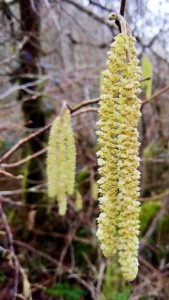
I have never deliberately grown it, and only occasionally relocate a jay-sown shrubling popping up in an inconvenient spot, redeploying it for some citizen rewilding. Cutting fresh stems, amid clouds of pollen, ready to stake this summer’s greenhouse tomatoes, has me pondering all the ways in which hazel has aided, improved and enriched my evolving garden over two decades.
First there is the promise and joy: the promise of spring to come, when the juvenile grey-green catkins begin to fatten in autumn, then on through winter, until their tight, dangling concertinas open up, scattering pale pollen-puffs onto the first mild breezes. Early-flying honey bees forage on hazel pollen, although being so light – hazel relies on wind, not insects, for pollination – it’s devilishly hard for them to scoop it up.
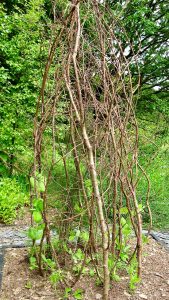
Catkin time is the ideal moment to start cutting sticks – or rods – of hazel, and to coppice existing plants. Coppicing is an art in itself, but in a garden or allotment, we can mould the rules to fit what we need hazel for. I use hazel stems between 10mm and 25mm thick as all-round plant supports, both for greenhouse crops and for various plants growing outdoors.
The thinner, twiggier ends of hazel stems are heaven for the tendrils of peas and sweet peas, which happily clamber up and over them. I make sweet pea pillars using 1.8m-long twiggy shoots, pushed into the ground, bunched tightly together at the top and tied with twine (a slimmer version works in a big pot in my greenhouse, giving extra-early pods and blooms). In autumn the whole lot can be put through a shredder and composted, or used as mulch.
Hazel twigs can be pushed in among the emerging shoots of flop-prone perennials, while pigeons loathe landing on and being amongst thin shoots they can’t see, so you can use them as a harmless, home-grown crop-saving deterrent.
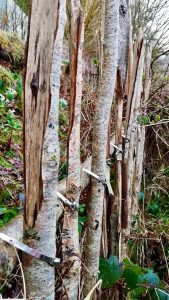
Stronger, thicker rods will carry runner and other climbing beans up to the sun, and I use them to brace tall, heavy-headed sunflowers against the sudden, stem-snapping summer storms we’re increasingly prone to.
Rods upwards of 25mm thick are ideal for splitting lengthways using a billhook. I’m still learning this gentle art; it takes skill and practice to successfully guide a blade down the length of a 1.5m-long hazel rod, but it’s also one of the most focusing, meditative activities I know. I use split rods as replacement uprights for my paling boundary fence; they last years if kept away from the soil, and look quite at home.
I harvest rods from several coppiced plants. Left alone, hazel can grow into a large shrub or small tree up to 12m tall, but coppicing modifies its natural growth in favour of the gardener. Coppicing is simply cutting a woody shrub or tree right down to within 5cm to 10cm of the ground. In response, the woody base or ‘stool’ of the plant sends up a number of fast-growing new shoots. When these reach the size you need, you can harvest them by cutting them close to the ground, triggering the growth of a new crop of shoots. In woodlands coppiced for products, this is done on a five to 10-year rotation.
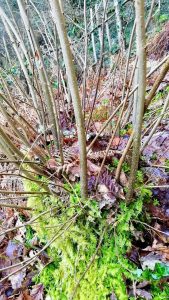
Here, I bend the rules. Some plants are coppiced in one go and then left alone for several years, while from others I take just the usable rods I need, leaving thinner ones to fatten up for another season. If you need mostly pea/perennial sticks, you’ll be content with twiggy shoots of one to two years old, but for climbing beans, pumpkins and squash, rods of three to four years old are winners. If you don’t need the thinner bits, shred them and add them to your compost heap or bin, or use them as mulch. Nothing goes to waste with heroic hazel.
The tough, woody stool where new shoots sprout from becomes its own micro-habitat. Dead leaves gather here, making the mini labyrinth a damp, cool and shady retreat for an array of wild life: frogs, toads, newts, slugs, snails and darting voles all stop off here. The dappled shade cast by hazel’s hairy summer leaves makes it a happy companion for hellebores, primroses, snowdrops and wild daffodils. During summer, the dense leafy canopy gives cover for small birds – especially those with our local sparrowhawk on their tail.
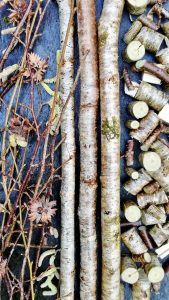
Summer, when shoots are lengthening and fattening, is when I tap into one of hazel’s little-known superpowers: as a life-boosting addition to soil. It’s always odd to be cutting down hazels when they’re full-on leafy (I take just a few rods from several stools), but their stems and foliage are bursting with minerals, amino acids, enzymes, proteins and plant food.
If you shred them into sappy, sweet-smelling wood chips (rods up to 7cm thick are ideal; I add in some willow, too), and then work them into the top few centimetres of soil – especially if it’s poor and jaded – life will come rushing back. By autumn, the chips will be swaddled in fungal mycelium and the soil will buzz with microbial life; look out for flushes of toadstools. You don’t have to wait for summer to unleash this superpower; chipped hazel can go into your soil today.
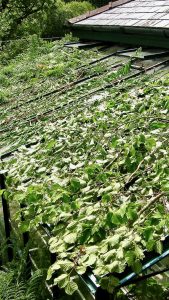
If you’re canny, you can double up on hazel’s summer usefulness. Big, leafy branches can be cut to add instant, free and plastic-free shading to your greenhouse roof during future heatwaves (or just lay them against the glazing of a scorching porch). They’re easily lifted on and off, and when the hot spell is gone, they can be shredded and added to your soil, or spread as mulch. Every last scrap is useful.
When hazel adds its glowing rusty-yellow hues to autumn, it’s time to let some leaves fall into the stool, to top up the wildlife refuge, and make leaf mould with the rest.
Perhaps hazel’s most understated superpower is that its roots are not invasive, making it a good choice for almost any garden or allotment, even a modest-sized one (it won’t menace pipes or building foundations like willows can). Aim to plant hazels in groups of three to five; they struggle to get going solo, and fare better in cool, moist soil (work in loads of leaf mould at planting time).
That shaded ‘problem’ spot in your garden could be crying out to become your very own rod and twiggy stick-producing, soul-calming, soil-enriching, shade-giving, leaf mould-making, wildlife-sheltering, delight-bringing and nature-powered, renewable resource.
Wondering about the nuts? Squirrels take all.
Text and images © John Walker
Find John on Twitter @earthFgardener










